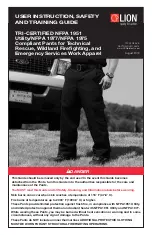
13
BURNS
Burns are a function of time and temperature. The higher
the temperature of the heat source and the longer the
exposure time, the greater the severity of burns.
FIRST DEGREE BURNS
begin when skin temperature
reaches approximately
118° F.
SECOND DEGREE BURNS
occur when skin temperature
reaches approximately
131° F.
THIRD DEGREE BURNS
occur when skin temperature
reaches approximately
152° F.
Radiant heat from hot
surfaces and flames can
cause burns
These NFPA 1951 Utility/NFPA 1977/NFPA 1975 Tri-Certified Pants do NOT include
a thermal barrier for insulation against heat. To prevent being burned, you must
not wear the Pants in high temperature environments and avoid contact with any
hot surfaces.
!
DANGER
You must only use the Technical Rescue/Wildland Firefighting/Station-Work Pants in
environments where no structural or proximity fire is present. In rescue situations where
fire is present, responders must also wear NFPA 1971 compliant structural or proximity
firefighter clothing.
!
DANGER
The buildup of heat in NFPA 1951 Utility/NFPA 1977/NFPA 1975 Tri-Certified Pants can
lead to burns without any sign of damage to the Pants. Never wait for signs of Pants
damage to warn of imminent burns. Always be aware of your surrounding environment
and be ready to escape if you begin to feel tingling or burning sensations.
!
DANGER
Technical Rescue and/or Wildland Firefighting personnel who are exposed to a flashover,
back-draft, or other flame and high heat environments are at
EXTREME
risk for extensive
burn injuries and death even while wearing their NFPA 1951 Utility/NFPA 1977/NFPA 1975
Tri-Certified Pants!
!
DANGER
Compression against hot
surfaces can cause burns
Minimal protection against conductive burns:
You
can be burned by conductive heat when you contact
heated surfaces or objects. Your Technical Rescue/Wildland
Firefighting garment does not include a thermal liner, and
therefore the Pants provides only minimal protection from
conductive burns. It is critical to avoid contact with any
hot surfaces while wearing the Technical Rescue/Wildland
Firefighting garment.
Minimal protection against convection burns:
Convected heat travels through the air, even if there is
no immediate appearance of fire. However, convected
heat can elevate the temperature of your Pants enough
to cause a conductive heat burn when the fabric comes
into contact with your skin. Your Pants does not have a
thermal liner. Therefore, NFPA 1951 Utility/NFPA1977/
NFPA 1975 Tri-Certified Pants should not be used in
situations of high temperature.
Summary of Contents for NFPA 1975
Page 22: ...22 NOTES...
























